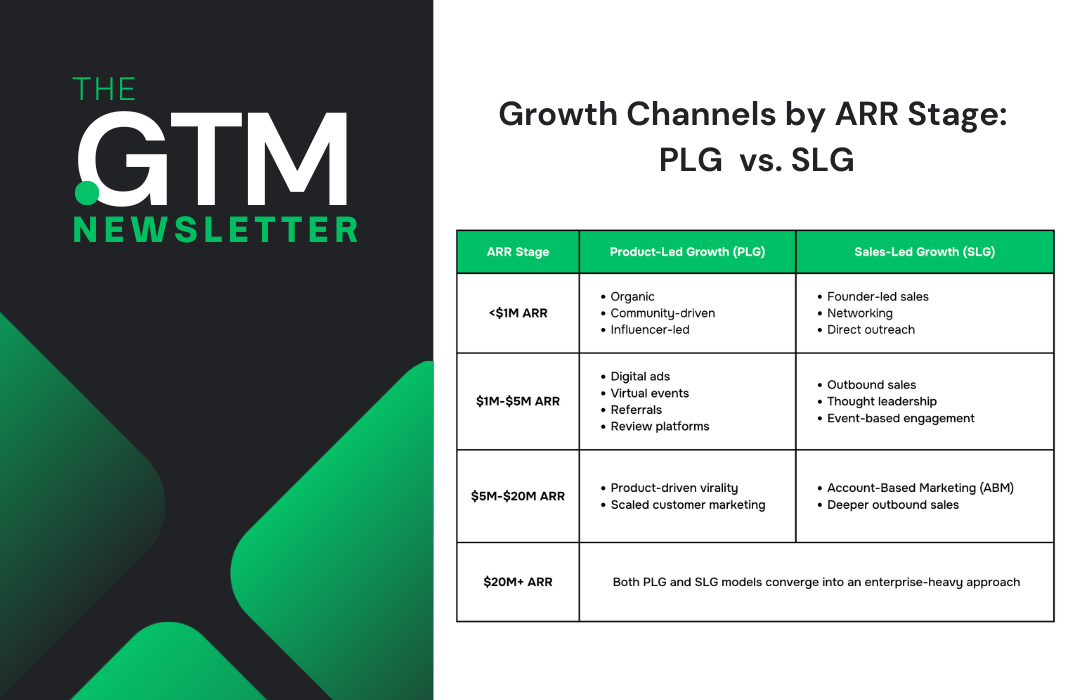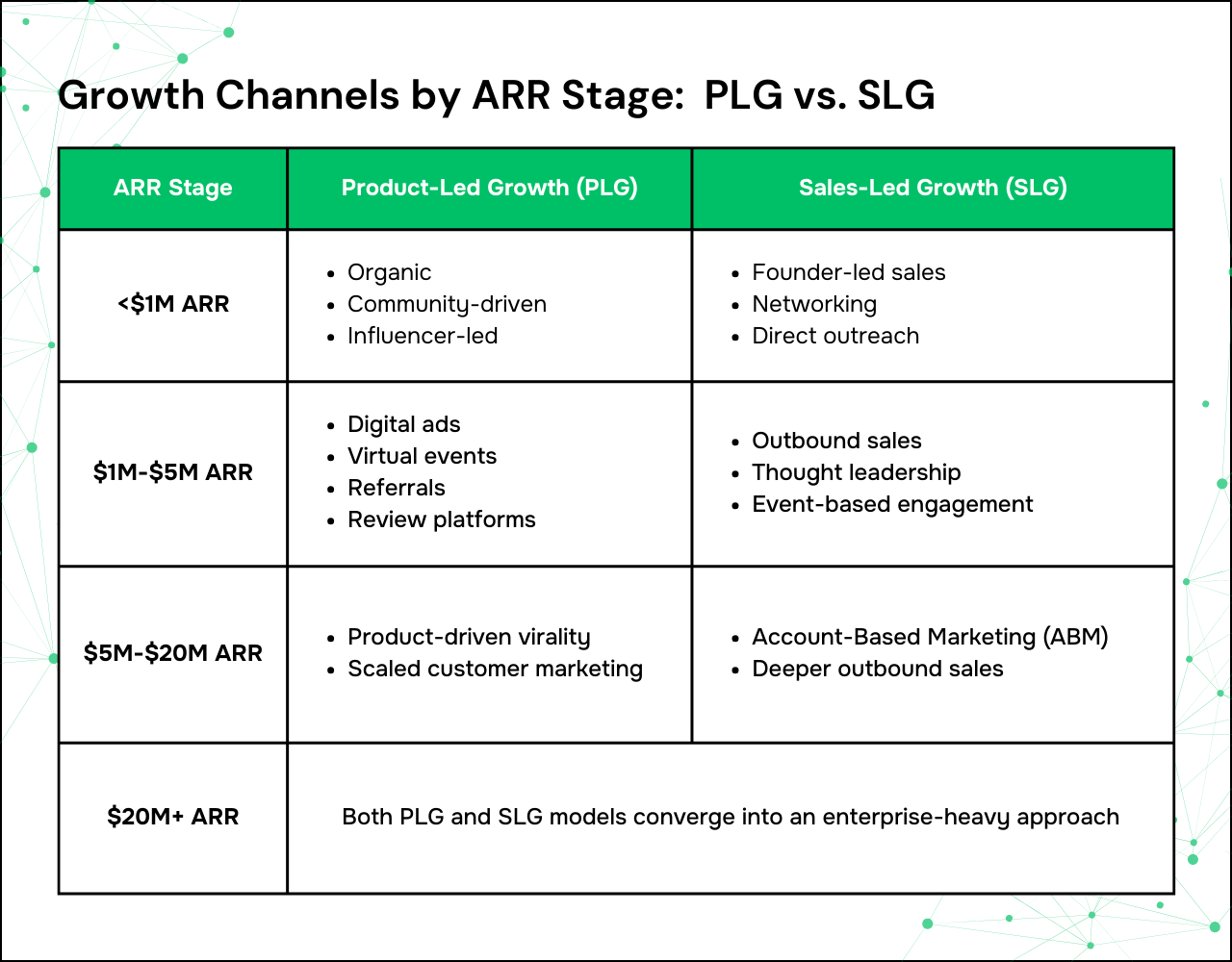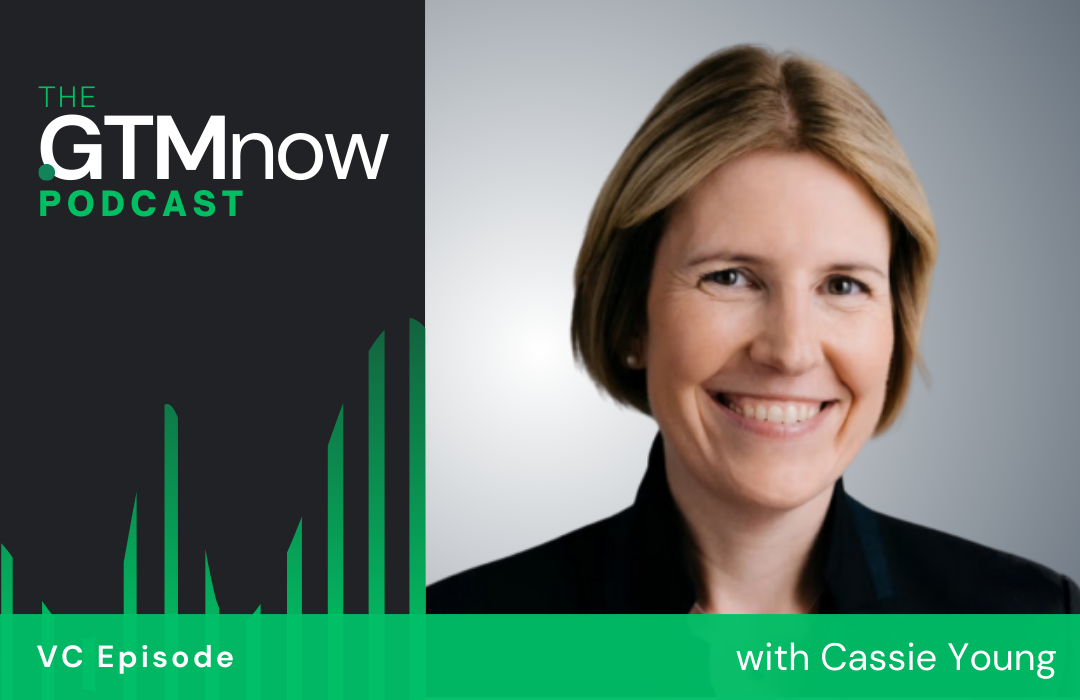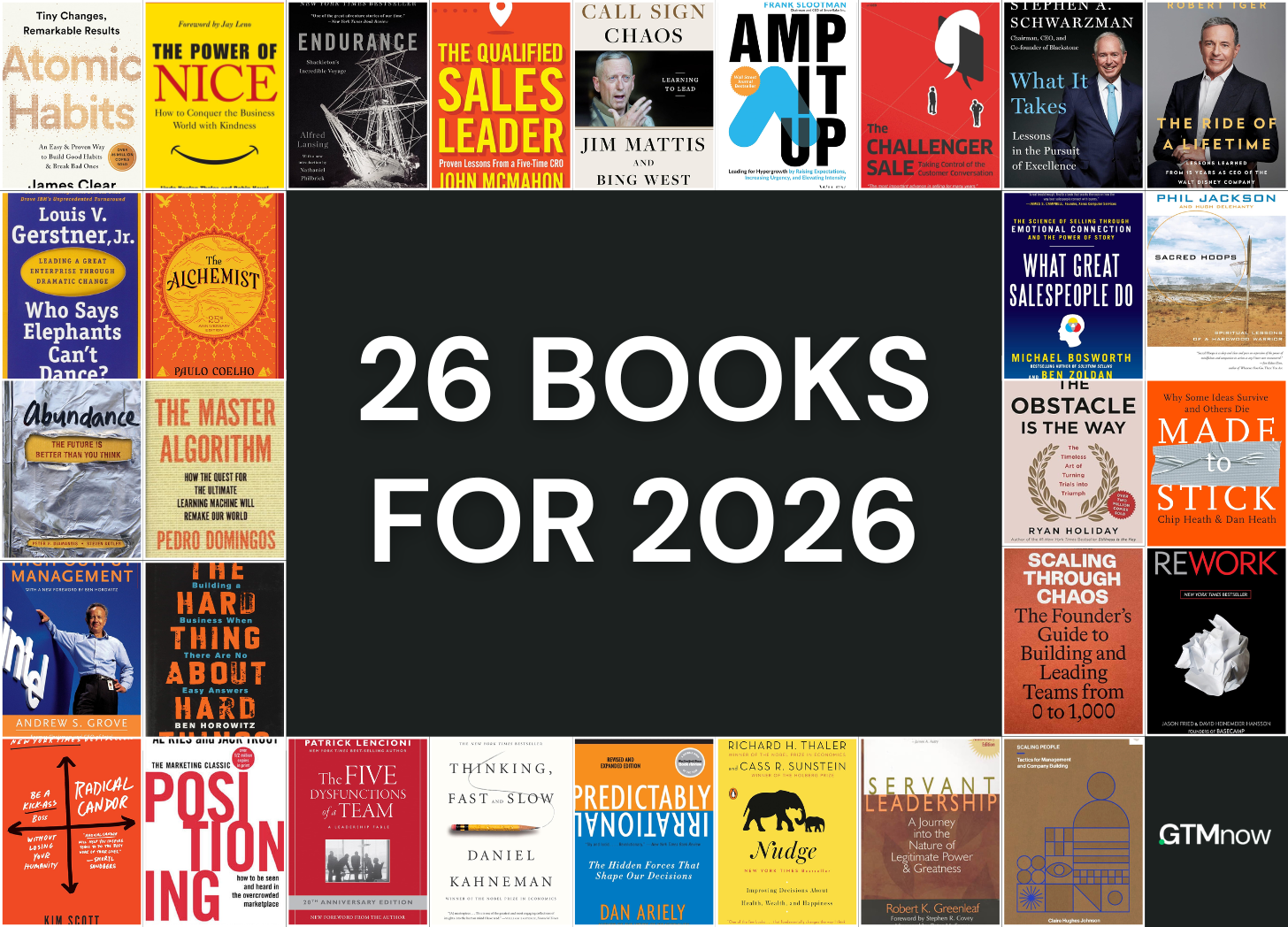How to navigate the shift from Product-Led Growth to Enterprise

Hello and welcome to The GTM Newsletter by GTMnow – read by 50,000+ to scale their companies and careers. GTMnow shares insight around the go-to-market strategies responsible for explosive company growth. GTMnow highlights the strategies, along with the stories from the top 1% of GTM executives, VCs, and founders behind these strategies and companies.
Every great Product-Led Growth (PLG) company eventually faces a crossroads: When and how to introduce a Sales-Led Growth (SLG) motion. Many make this shift reactively rather than strategically.
PLG and SLG aren’t competitors, they’re partners in growth. Companies that seamlessly bridge the two unlock incredible scale. Success requires a data-driven approach, a customer-first mindset, and a willingness to embrace change.
In this piece, GTM leaders share key lessons on how to navigate this transition effectively while keeping a customer-first approach.

Growth isn’t a choice, your customers decide it
Companies often reach a tipping point where users demand enterprise features, security, and team-wide adoption. Rather than resisting the transition, companies should follow customer behavior signals and build a sales motion that complements, rather than competes, with PLG.
3 key indicators that it’s time to introduce SLG:
- Customers requesting enterprise features (SSO, security, admin controls).
- Teams organically growing within accounts.
- Inbound requests for larger contracts and enterprise agreements.
PLG to PLS: Understanding the evolution
Growth strategies evolve as companies scale. Holly Chen breaks it down:

In the early days, PLG can feel like magic – users sign up and adoption grows without direct sales interaction. But as companies move upmarket, they often transition from PLG to PLS.
Why make this shift? Andrew Johnston explains:
- Complex customer needs: Larger customers demand more personalized support, security, and integrations.
- Enterprise sales cycles: Moving upmarket means more stakeholders, approvals, and custom solutions.
- Revenue potential: Without a sales motion, high-value accounts may remain untapped.
The PLG-SLG hybrid is harder than it looks
While hybrid PLG-SLG models offer massive upside, they also introduce complexity. Common pitfalls:
- Resource allocation conflicts: Enterprise and PLG teams require different marketing, sales, and product support – creating an internal tug-of-war.
- Website & CTA prioritization: Should the homepage push free trials, demos, or enterprise sales? Striking a balance is tough.
- Product & engineering trade-offs: PLG requires simplicity, while enterprise customers demand customization. Prioritization is key.
Companies that succeed in hybrid motions are those that treat PLG and SLG as complementary rather than separate business units.
How to nail the PLG-SLG transition
1. Map the customer Journey from PLG to Enterprise
- Identify patterns in how free users evolve into enterprise buyers.
- Look for specific in-product behaviors that indicate expansion potential (e.g., integrations, increased seat count).
2. Define your Product-Qualified Lead (PQL) criteria
- Reverse-engineer signals from past enterprise deals to define high-potential PQLs.
- Use personalized, value-driven outreach when engaging them.
- Avoid generic “Want to talk to sales?” emails—offer specific solutions based on their usage.
3. Unify PLG and SLG teams under a shared customer strategy
- Marketing and sales shouldn’t work in silos; they should co-own growth.
- Prioritize customer experience over internal attribution battles.
- Build a single source of truth for customer data across marketing, sales, and product teams.
4. Create an operating and governance model for data and decision-making
- Establish an Operating Committee of directors/VPs across departments to collaborate on major shifts.
- Have a Governing Committee (C-suite) to provide executive alignment and unblock major roadblocks.
- Ensure that data and analytics are centralized, accurate, and actionable.
Examples: Asana & Calendly’s PLG-SLG evolution
Jessica Gilmartin, former CMO and CRO at Calendly and Head of Revenue Marketing at Asana, shares insight to Asana and Calendly’s evolutions.
Calendly: Using product signals to drive enterprise sales
Calendly leveraged integration data to identify high-value users. If an executive-level user connected their calendar to Salesforce, it signaled serious intent. Instead of pushing an immediate sales call, they received a targeted outreach offering value (e.g., helping them optimize that integration).
Asana: The balancing act of enterprise and PLG
At Asana, the team initially kept enterprise marketing and PLG marketing completely separate. Over time, they realized this fragmented approach didn’t align with how customers actually purchased. The solution? A holistic view of the customer journey, ensuring that enterprise buyers had a self-serve experience before engaging with sales.
Tag GTMnow so we can see your takeaways and help amplify them.
👂 More for your eardrums
Jaleh Rezaei is the CEO & Co-founder of Mutiny, a company reimagining the B2B buying experience by transforming transactional relationships into meaningful connections through AI-powered personalization. Mutiny helps enterprises restore the human element in modern buying at scale, and is used by some of the fastest growing companies in the world including Amplitude, Snowflake and Qualtrics. The company is backed by Sequoia Capital, Tiger Global, and CMOs of companies such as Uber, Condé Nast and Salesforce. Prior to Mutiny, Jaleh was the Head of Marketing and Business Development at Gusto, where she grew the company from 500 to 50,000 customers over 4 years. She was the Director of Product Marketing at VMware prior to Gusto.
Listen on Apple, Spotify, YouTube, or wherever you get your podcasts by searching “The GTM Podcast.”
🚀 Startup to watch
Armada – named #1 on the list of Fast Company’s Most Innovative Companies of 2025. The edge computing platform delivers connectivity and real-time data in remote regions, with usages appropriate for first responders, the military, and critical infrastructure industries such as gas and oil.
Bite – named one of Fast Company’s Most Innovative Companies of 2025. Bite’s kiosk ordering software is designed to delight customers with things like secret menus and surprise freebies, transforming the hospitality experience.
Spekit – CEO & Co-Founder Melanie Fellay launched a book, “Just-In-Time: The Future of Enableement in a World of AI.” Not your typical business book, this is woven with stories and industry expert perspectives.
👀 More for your eyeballs
Lessons in product scaling and storytelling from Figma’s CPO. The playbook behind the the gnarly phase of product building that arrives after a startup achieves product-market fit.
GTMfund’s Operator-led model. Partners Paul Irving and Scott Barker break down the model on AngelList’s Industry Stories series.
You can’t be bringing your old playbook around. There are things you can learn from it, but you have to build a new one everywhere you go.
🔥 Hottest GTM jobs of the week
- Director Lifecycle Marketing at Owner (Remote – US)
- Business Development Representative at Stotles (London)
- Sales Development Representative at Vanta (Hybrid – San Francisco)
- Customer Success Manager – Enterprise at UserEvidence (San Luis Obispo, CA/Denver, CO/Nashville, TN/Salt Lake City, UT/Jackson Hole, WY)
- Director, Strategic Customer Success at Writer (Hybrid – Austin)
See more top GTM jobs on the GTMfund Job Board.
If you’re looking to scale your sales and marketing teams with top talent, we couldn’t recommend our partner Pursuit more. We work closely together to be able to provide the top go-to-market talent for companies on a non-retainer basis.
See more top GTM jobs on the GTMfund Job Board.
If you’re looking to scale your sales and marketing teams with top talent, we couldn’t recommend our partner Pursuit more. We work closely together to be able to provide the top go-to-market talent for companies on a non-retainer basis.
🗓️ GTM industry events
Upcoming go-to-market events you won’t want to miss:
- The GTM Workshop for AI Founders – a GTMfund event: March 25, 2025 (San Francisco, CA) – private registration (email for details)
- GTMfund Dinner: March 25, 2025 (San Francisco, CA) – private registration
- More GTMfund events TBA
- Spryng by Wynter: March 24-26, 2025 (Austin, TX)
- Pavilion CMO Summit: April 17, 2025 (Atlanta, GA)
- SaaStr Annual: May 13-15 (San Francisco, CA)
- Web Summit: May 27-30, 2025 (Vancouver, CAN)
- Pavilion CRO Summit: June 3, 2025 (Denver, CO)
- Pavilion GTM Summit: September 23-25, 2025 (Washington, DC)



